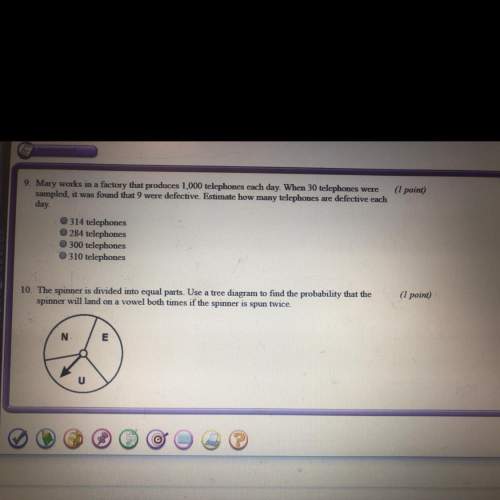The graph of f(x) is shown.
On a coordinate plane, a parabola opens up. It goes through...

Mathematics, 23.05.2020 16:58 emma042902
The graph of f(x) is shown.
On a coordinate plane, a parabola opens up. It goes through (negative 1.75, 4), has a vertex of (negative 0.25, negative 3), and goes through (1.4, 4). Solid circles appear on the parabola at (negative 1.6, 3.1), (negative 1.2, 0), (negative 0.25, negative 3), (0.8, 0), (1.2, 3.1).
Over which interval on the x-axis is there a negative rate of change in the function?
–2 to –1
–1.5 to 0.5
0 to 1
0.5 to 1.5

Answers: 2
Another question on Mathematics

Mathematics, 21.06.2019 18:20
Match each inequality to the number line that represents its solution
Answers: 3

Mathematics, 22.06.2019 01:10
Evaluate 8x2 + 9x − 1 2x3 + 3x2 − 2x dx. solution since the degree of the numerator is less than the degree of the denominator, we don't need to divide. we factor the denominator as 2x3 + 3x2 − 2x = x(2x2 + 3x − 2) = x(2x − 1)(x + 2). since the denominator has three distinct linear factors, the partial fraction decomposition of the integrand has the form† 8x2 + 9x − 1 x(2x − 1)(x + 2) = correct: your answer is correct. to determine the values of a, b, and c, we multiply both sides of this equation by the product of the denominators, x(2x − 1)(x + 2), obtaining 8x2 + 9x − 1 = a correct: your answer is correct. (x + 2) + bx(x + 2) + cx(2x − 1).
Answers: 3

Mathematics, 22.06.2019 02:30
Atrain traveled for 1.5 hours to the first station, stopped for 30 minutes, then traveled for 4 hours to the final station where it stopped for 1 hour. the total distance traveled is a function of time. which graph most accurately represents this scenario? a graph is shown with the x-axis labeled time (in hours) and the y-axis labeled total distance (in miles). the line begins at the origin and moves upward for 1.5 hours. the line then continues upward at a slow rate until 2 hours. from 2 to 6 hours, the line continues quickly upward. from 6 to 7 hours, it moves downward until it touches the x-axis a graph is shown with the axis labeled time (in hours) and the y axis labeled total distance (in miles). a line is shown beginning at the origin. the line moves upward until 1.5 hours, then is a horizontal line until 2 hours. the line moves quickly upward again until 6 hours, and then is horizontal until 7 hours a graph is shown with the axis labeled time (in hours) and the y-axis labeled total distance (in miles). the line begins at the y-axis where y equals 125. it is horizontal until 1.5 hours, then moves downward until 2 hours where it touches the x-axis. the line moves upward until 6 hours and then moves downward until 7 hours where it touches the x-axis a graph is shown with the axis labeled time (in hours) and the y-axis labeled total distance (in miles). the line begins at y equals 125 and is horizontal for 1.5 hours. the line moves downward until 2 hours, then back up until 5.5 hours. the line is horizontal from 5.5 to 7 hours
Answers: 1

Mathematics, 22.06.2019 04:00
Generate two equivalent fractions for each fraction. use fraction tiles or number lines . 3/4
Answers: 3
You know the right answer?
Questions



Mathematics, 22.01.2021 18:10

Biology, 22.01.2021 18:10


Computers and Technology, 22.01.2021 18:10


Chemistry, 22.01.2021 18:10

Mathematics, 22.01.2021 18:10

Mathematics, 22.01.2021 18:10










Advanced Placement (AP), 22.01.2021 18:10




